72 Hours In Aion A Closed Beta Review
 Vancouver – No, that’s not 72 hours of straight playing. The long-awaited North American closed beta of NCSoft’s Aion began this past Thursday at noon Pacific time, and that’s when our resident PC game player, A.K.A. Cavechild, logged into the game – if he hadn’t been in need of sleep and food, he probably would have logged a straight 72 hours.
Vancouver – No, that’s not 72 hours of straight playing. The long-awaited North American closed beta of NCSoft’s Aion began this past Thursday at noon Pacific time, and that’s when our resident PC game player, A.K.A. Cavechild, logged into the game – if he hadn’t been in need of sleep and food, he probably would have logged a straight 72 hours.
The Aion build used for this testing is version 1.0, the most up-to-date version available. Players are limited to level 20 and certain map regions – but with so much to do and explore even within in this limited area, players can remain very occupied for this test period.
When I interrupted Cavechild’s play to ask him about Aion, the first question I put to him was to name one thing he did not like about the game. There are only two things thus far that he doesn’t like in the game: the fact that this is not the full release, and th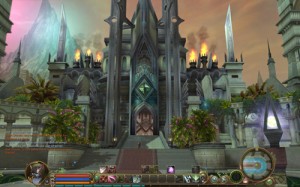 e apparent inability to turn off announcements from player stores – the well-known WTB and WTS scenarios. (For those unfamiliar with these acronyms – WTB is Want To Buy and WTS is Want To Sell).
e apparent inability to turn off announcements from player stores – the well-known WTB and WTS scenarios. (For those unfamiliar with these acronyms – WTB is Want To Buy and WTS is Want To Sell).
According to the Lore of Aion, the shell world of Atreia was once connected by the Tower of Eternity but a great cataclysm caused by the Balaur shattered the tower, separating the two worlds of Atreia. One side of Atreia is now inhabited by the Asmodian faction while the other is populated by the Elyos. Players will be able to explore these worlds as well as regions made up of voids and floating islands. As with many worlds, the two factions have an intense hatred of each other, and there is constant warring in The Abyss, the area between the two shattered regions. While the races battle each other, they must also contend with the greatest evil of all, the Balaur, previously only known to the factions through their Lore. It would seem that the factions may have to work together against the Balaur in order for what’s left of their world to survive.
The world of Aion thus far revealed is stunning. The environmental and character design is outstanding, with an amazing amount of attention paid to detail. Players can enter buildings such as markets, bars and the library. In the library, players can read books of Lore, learning more about the history of Aion and Atreia. While players can go to markets to buy upgrades, emotes and supplies, there are also player stores, where players can buy, sell and trade goods amongst themselves. Aion’s emote system gives the players some very cute and amusing expressions – I particularly liked Taunt and Birthday Celebration. I hope that Cav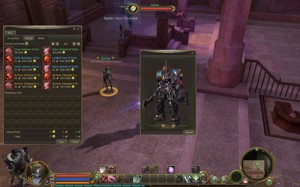 echild isn’t planning on making any money for his Warrior’s dancing though – unless it’s to provide amusement – although I will say that the character dance moves in Aion are much better than those in Guild Wars.
echild isn’t planning on making any money for his Warrior’s dancing though – unless it’s to provide amusement – although I will say that the character dance moves in Aion are much better than those in Guild Wars.
There are an abundance of quests and things to do aside from taking part in Player vs Player battles. Not all quests are received from NPCs, though. For example, once a Moss Bear at Idun’s Lake is defeated, a Tanner Knife is dropped, and the player is given the task of returning it to its owner. Quests usually offer high rewards of XP and Kinah, the currency of Aion. Skills are learned through the purchase and use of books; the higher a player’s level, the more expensive are the skills. Due to quest rewards, drops from enemies and product trade, it is reasonably easy to gain Kinah to make purchases.
Players can also purchase a Profession. Professions include six Production and two Gathering optio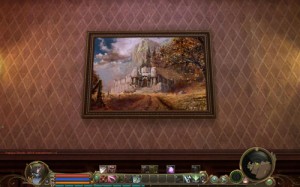 ns. The Gatherers collect materials throughout the world, which they can then give, sell or trade to the Production professions. The Production 0r Crafting Professions are Armoursmith, Weaponsmith, Cook, Alchemist, Sewing and Handiwork. The first three craft professions are self-explanatory. Alchemists specialize in the making of potions, while those who pursue Sewing will be able to make tailored cloth or leather armour. Handicrafters will be able to make jewelry, bows and staffs. While players will be able to purchase all six professions and take them to Expert level, it appears that only one profession can be taken to the Master level per character.
ns. The Gatherers collect materials throughout the world, which they can then give, sell or trade to the Production professions. The Production 0r Crafting Professions are Armoursmith, Weaponsmith, Cook, Alchemist, Sewing and Handiwork. The first three craft professions are self-explanatory. Alchemists specialize in the making of potions, while those who pursue Sewing will be able to make tailored cloth or leather armour. Handicrafters will be able to make jewelry, bows and staffs. While players will be able to purchase all six professions and take them to Expert level, it appears that only one profession can be taken to the Master level per character.
Not all enemies drop rewards, but scattered around the world are large chests. It seems that these chests can only be opened through force, and as they have a very high health level, it takes dedication on an individual’s part or a good group effort to open the chest. As Mike hasn’t opened a chest yet, I can’t say what is in it or if everyone in a group gains a reward from the chest once it is opened.
Mike chose to make an Asmodian Warrior as his primary character. While he did make characters of each class for experimentation, he has been concentrating on his warrior. The character creation controls offer high-customization possibilities, very similar to the build process in Oblivion. Players can even choose what type of voice their character will have, something which I find quite interesting. A feature in character creation which I personally really liked – and this carries throughout the game, as well – is the ability to see your character in different types of armour. This is a preview feature that I wish was available in G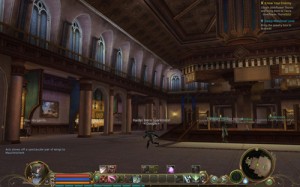 uild Wars and am hoping will be present in Guild Wars 2.
uild Wars and am hoping will be present in Guild Wars 2.
The audio tracks in Aion are outstanding. The music is dynamic, matching regions and situtaions perfectly. The soundtrack is epic, full of rich and moving pieces – something which can only be expected for a game as big as Aion. NPCs and enemies all have their own set of sayings and sounds, which only add to the player’s audial experience during play. Developers have also given players the option of turning off the background music, something which many gamers will appreciate, I’m sure.
The User Interface is fairly standard for the MMORPG genre of games. It is customizable insofar as players can move the fields around to suit their taste, and an active Quest Log can be toggled on or off on the side of the screen. Also as with other MMOs, players can switch server channels if they are experiencing lag or so that they can play with friends. Aion runs on a modified version of the CRY 1 Engine, and as stated earlier, gameplay is quite smooth and lag is minimal except for areas which may be very highly populated and/or have a lot of action going on such as the PvP battles. This said, it is recommended that computers meet if not exceed the minimum system requirements for game play, which you can find at the end of this article.
The primary classes available to players are: Warrior, Scout, Mage and Priest. Once a player reaches level 9 and ascends as a Daeva, he or she will gain wings and the ability to fly at level 10. The ability to fly opens up a whole new level of combat, as players take to the skies to fight. Also available at level 10 is the ability to specialize in a sub-class.
Warriors can become either a Templar or Gladiator. Gladiators can develop a wide variety of fighting skills as well as master many weapons, depending on their fighting style. Templars, much like the Templars of old, are warrior monks – they primarily use single-handed swords and shields, but they are also capable of healing others similar to the Priest Chanters.
Scouts can become Assassins or Rangers, with Rangers having the ability to observe and survive in harsh environments. They are not only bow masters, they can also become highly skilled wi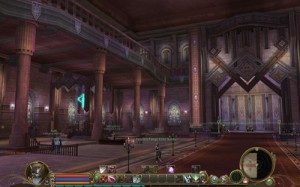 th other weapons such as blades. The Assassins are stealthy in the way only an assassin can be. They are very valuable members of the Legion (Guild) as they can kill swiftly and quietly.
th other weapons such as blades. The Assassins are stealthy in the way only an assassin can be. They are very valuable members of the Legion (Guild) as they can kill swiftly and quietly.
The two sub-classes available to Mages are Sorcerers or Spirit Master. Mages, generally known in the MMO world as “squishy” are not highly skilled in close quarter combat, but they are adept at dealing magical damage and protections. Sorcerers rely on the elements of magic – water, fire, earth and air for their battle skills, while Spirit Masters can summon “pets” who assist in battle.
Priests are able to heal allies and meddle with the enemy. Players can become Clerics or Chanters at level 10, and while still in the “squishy” category, they are able to assist in melee battle. Clerics can battle with single-handed weapons, but their primary purpose is healing and temporary ally buffing. Chanters use powerful mantras to protect and buff their allies, as well as raise their morale in a way similar to the Paragon class in Guild Wars.
Once a character is created and saved, it is off to the training area, which seasoned MMO players often refer to as “Noob Island” – even though these areas aren’t always an island, such as in the Pre-Searing chapter in Guild Wars Prophecies. It appears that players are limited to this area until at least level 9, when Ascension to Daeva is obtainable, although Mike did not try to leave the area sooner, so this is not a definite. Players are not forced to leave, they can stay and further level up their characters and abilities.
While Player vs Player is not the focus of this closed beta (there are more betas scheduled over the coming weeks, which we will be writing about), gamers can challenge members of their own faction to duels, but it doesn’t appear that there are any special rewards for winning a duel.
There are three modes of travel around the map. Players can take the old-fashioned way of walking (or flying once able), or they can purchase Quick Flight to get between locations such as towns; the third method is Teleportation for travel between primary cities in each province. Travel by Teleportation also requires the payment of a fee.
Character storage has almost always been an issue for MMO players. There never seems to be enough or the right kind. In Aion, players can use both character-specific and account-wide storage systems. Both methods are quite self-explanatory, but for those unfamiliar with MMO play, character-specific storage would be used for personalized items such as weapons and armour, whereas account-wide storage could be used for items available for use by all of a player’s characters.
The dev team has obviously put a lot of effort into the building of Aion, and excitement for the game’s release in North America is building daily. Whether or not it will see many converts from the realms of World of Warcraft, Conan The Barbarian and Guild Wars. For me personally, I am torn about whether or not to purchase the game due to the subscription requirements. While I do pay for things like a Gold Membership on XBL, I have never played a PC game which requires a monthly subscription fee. I rather like being able to play (or not play) Guild Wars as I like without feeling the obligation to play because it’s costing me money on a monthly basis. That said, Aion is an amazing game with an incredible amount of depth and story incorporated into the game play. It would be well worth the $15.00 (USD) per month subscription fee for those who have the time and money to play on a regular basis – particularly if there are regular additions to the game in the way of free downloadable content as well as paid expansion chapters.
Until next time, these have been our thoughts on the Aion Closed Beta play.
System Requirements:
Minimum:
Pentium 4 2.8GHz, AMD Athlon 2800+; 1 GB RAM; GeForce 6600, Radeon X1550; Hard Drive 30GB; DirectX 9.0c(2008,6)
Recommended:
Pentium Dual Core, AMD Athlon 64 X2; 2 GB RAM; GeForce 7600, Radeon HD 2600; Hard Drive 30GB; DirectX 9.0c(2008,6)



